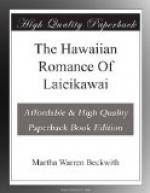CHAPTER XII
[Footnote 46: In the story of Kapuaokaoheloai we read that the daughter of the king of Kuaihelani, the younger brother of Hina, has a daughter who lives apart under a sacred taboo, with a bathing pool in which only virgins can safely bathe, and “ministered to by birds.” Samoan accounts say that the chiefs kept tame birds in their houses as pets, which fluttered freely about the rafters. A stranger unaccustomed to such a sight might find in it something wonderful and hence supernatural.]
CHAPTER XIII
[Footnote 47: A strict taboo between man and woman forbade eating together on ordinary occasions. Such were the taboo restrictions that a well-regulated, household must set up at least six separate houses: a temple for the household gods, heiau; an eating house for the men, hale mua, which was taboo to the women; and four houses especially for the women—the living house, hale noa, which the husband might enter; the eating house, hale aina; the house of retirement at certain periods, which was taboo for the husband, hale pea; and the kua, where she beat out tapa. The food also must be cooked in two separate ovens and prepared separately in different food vessels.]
[Footnote 48: The place of surf riding in Hawaiian song and story reflects its popularity as a sport. It inspires chants to charm the sea into good surfing—an end also attained by lashing the water with the convolvulus vine of the sea beach; forms the background for many an amorous or competitive adventure; and leaves a number of words in the language descriptive of the surfing technique or of the surf itself at particular localities famous for the sport, as, for example, the “Makaiwa crest” in Moikeha’s chant, or the “Huia” of this story. Three kinds of surfing are indulged in—riding the crest in a canoe, called pa ka waa; standing or lying flat upon a board, which is cut long, rounded at the front end and square at the back, with slightly convex surfaces, and highly polished; and, most difficult feat of all, riding the wave without support, body submerged and head and shoulders erect. The sport begins out where the high waves form. The foundation of the wave, honua, the crest side, muku, and the rear, lala, are all distinguished. The art of the surfer lies in catching the crest by active paddling and then allowing it to bear him in swift as a race horse to the hua, where the wave breaks near the beach. All swimmers know that three or four high waves follow in succession. As the first of these, called the kulana, is generally “a high crest which rolls in from end to end of the beach and falls over bodily,” the surfer seldom takes it, but waits for the ohu or opuu, which is “low, smooth and strong.” For other details, see the article by a Hawaiian from Kona, published in the Hawaiian Annual, 1896, page 106.]




